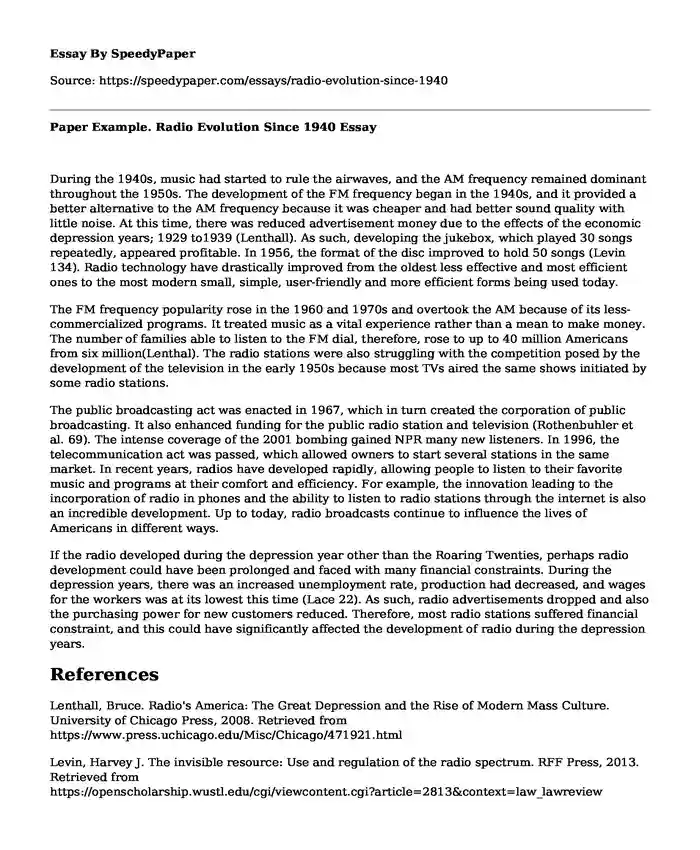During the 1940s, music had started to rule the airwaves, and the AM frequency remained dominant throughout the 1950s. The development of the FM frequency began in the 1940s, and it provided a better alternative to the AM frequency because it was cheaper and had better sound quality with little noise. At this time, there was reduced advertisement money due to the effects of the economic depression years; 1929 to1939 (Lenthall). As such, developing the jukebox, which played 30 songs repeatedly, appeared profitable. In 1956, the format of the disc improved to hold 50 songs (Levin 134). Radio technology have drastically improved from the oldest less effective and most efficient ones to the most modern small, simple, user-friendly and more efficient forms being used today.
The FM frequency popularity rose in the 1960 and 1970s and overtook the AM because of its less-commercialized programs. It treated music as a vital experience rather than a mean to make money. The number of families able to listen to the FM dial, therefore, rose to up to 40 million Americans from six million(Lenthal). The radio stations were also struggling with the competition posed by the development of the television in the early 1950s because most TVs aired the same shows initiated by some radio stations.
The public broadcasting act was enacted in 1967, which in turn created the corporation of public broadcasting. It also enhanced funding for the public radio station and television (Rothenbuhler et al. 69). The intense coverage of the 2001 bombing gained NPR many new listeners. In 1996, the telecommunication act was passed, which allowed owners to start several stations in the same market. In recent years, radios have developed rapidly, allowing people to listen to their favorite music and programs at their comfort and efficiency. For example, the innovation leading to the incorporation of radio in phones and the ability to listen to radio stations through the internet is also an incredible development. Up to today, radio broadcasts continue to influence the lives of Americans in different ways.
If the radio developed during the depression year other than the Roaring Twenties, perhaps radio development could have been prolonged and faced with many financial constraints. During the depression years, there was an increased unemployment rate, production had decreased, and wages for the workers was at its lowest this time (Lace 22). As such, radio advertisements dropped and also the purchasing power for new customers reduced. Therefore, most radio stations suffered financial constraint, and this could have significantly affected the development of radio during the depression years.
References
Lenthall, Bruce. Radio's America: The Great Depression and the Rise of Modern Mass Culture. University of Chicago Press, 2008. Retrieved from https://www.press.uchicago.edu/Misc/Chicago/471921.html
Levin, Harvey J. The invisible resource: Use and regulation of the radio spectrum. RFF Press, 2013. Retrieved from https://openscholarship.wustl.edu/cgi/viewcontent.cgi?article=2813&context=law_lawreview
Rothenbuhler, Eric, and Tom McCourt: Radio redefines itself, 1947-1962. Radio reader: Essays in the cultural history of radio, 2002. Retrieved from http://ebscohost.com
Cite this page
Paper Example. Radio Evolution Since 1940. (2023, Mar 22). Retrieved from https://speedypaper.net/essays/radio-evolution-since-1940
Request Removal
If you are the original author of this essay and no longer wish to have it published on the SpeedyPaper website, please click below to request its removal:
- The Issues of Cohabitation
- Philosophy Essay Example: Plato's Philosophy Learning is Recollection
- Essay Sample Describing Reports in Google Analytics
- Free Essay Example: Business Analytics in CRM
- Essay Sample on the Chief Ethics Officer
- Foundation of Theory of Organization - Free Paper Sample
- Analysis of Literature Reviews For the Thesis; Center for Art and Music - Essay Sample
Popular categories





